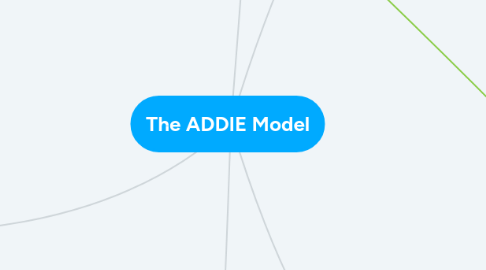
1. Developement
1.1. Description
1.1.1. This is the stage where the course is created. Each element of the course should be developed to match the design phase.
1.2. Tasks
1.2.1. Build modules, lessons and assessments according to what's been determined in the Design phase
1.2.2. UI/UX: Apply eLearning and visual design best practices to improve learning outcomes
1.2.3. Conduct alpha testing: manually select a group of testers to check for accuracy of the contact and utility of the navigation.
1.3. (Formative) evaluation
1.3.1. The development process should be iterative. Testing must look at grammar, spelling, syntax, etc, the mechanics and the navigation. Testing the course is not flicking through it - it is a systematic check on the accuracy of the content and the utility of the navigation.
1.3.1.1. Some useful questions
1.3.1.1.1. Can a learner progress in the way that was designed?
1.3.1.1.2. What happens if they make unexpected decisions?
1.3.1.1.3. Is the course engaging?
1.3.1.1.4. Is the course the right length?
1.3.1.1.5. Is it accessible to our audience?
1.3.1.1.6. Does it work well with any characteristics of the audience?
1.4. Outcome
1.4.1. Course Content
2. Implementation
2.1. Description
2.1.1. Now it's time to share the course with the learners. The decisions made in the design phase will influence how this is carried out, for example, uploading the course materials into our LMS. During the implementation phase, a procedure for training the facilitators and learners is developed.
2.1.1.1. The facilitator training should cover course curriculum, learning outcomes, method of delivery, and testing procedures.
2.1.1.2. Learner training should make sure the learners can use the technology correctly and easily and know who to contact with questions or techincal problems.
2.2. Tasks
2.2.1. Deploy learning content and make it accessible to learners
2.2.2. (optional) Carry out beta-testing: allow early users to voluntarily sign up as beta-testers, accessing the full content with the goal of checking their performance and obtaining their feedback.
2.2.3. Train facilitators
2.2.4. Train students of the use of the technology
2.3. (Formative) evaluation
2.3.1. The instructional designer should monitor the situation to prevent technical issues. Conducting a pilot of a course before unleashing the content on the entire group is normally a good practice.
2.4. Outcomes
2.4.1. The content is available to the learners, and they can start their learning.
3. Evaluation
3.1. Description
3.1.1. One of ADDIE’s main features is its ability for improving the way in which future iterations of the course are created. This is where we gather knowledge from the whole ADDIE process with the intention of restarting the cycle and improving the course.
3.2. Tasks
3.2.1. Gather data from technology platform (LMS)
3.2.2. Gather data from feedback forms and voluntary feedback from learners
3.2.3. Analyze data
3.2.4. Identify weak parts of the course, new training requirements and opportunities for improvement
3.3. Evaluation
3.3.1. Formative evaluation: Although evaluation is listed as the last phase of ADDIE, most developers use evaluation in every stage of their project.
3.3.2. Summative evaluation consists of getting feedback on every aspect of the course to improve and revise the content in the next iteration. Some technological tools provide information on the learners performance and activity, which can help us see some weak points. We can also design surveys and encourage learners to give feedback. What to focus on:
3.3.2.1. Take feedback and place it back into the analysis phase.
3.3.2.2. Did we meet the goals as set out in the analysis phase?
3.3.2.3. Identify other training requirements.
3.3.2.4. Possible change in media types or approach.
3.4. Outcome
3.4.1. Valuable information to restart the process and improve the course.
4. Design
4.1. Description
4.1.1. In the design phase, we take all of the learnings of the previous phase and use them to make practical decisions. This includes a strategy, delivery methods, structure, duration, lesson planning, media selection, assessment, and feedback.
4.2. Tasks
4.2.1. Translate the program objectives into terminal and enabling learning objectives
4.2.2. Quantify project development, implementation, and evaluation costs and effort required
4.2.3. Determine program structure and sequence
4.2.4. Determine program duration and pace
4.2.5. Decide program format and mode of delivery
4.2.6. Plan lessons
4.2.7. Select media
4.2.8. Define implementation and training administrational requirements.
4.3. (Formative) evaluation
4.3.1. An initial testing phase of a prototype is always a good idea, this is a sanity check that is carried out prior to moving too far forward.
4.4. Outome
4.4.1. An overview of the course design and storyboards/prototypes.
5. Analysis
5.1. Description
5.1.1. Before developing any content or training strategies, we need to analyze the current situation. This phase is a full audit to identify the instructional problem, the goals and objectives, the learning environment and learner's existing knowledge and skills.
5.1.1.1. Some useful questions
5.1.1.1.1. Why are we doing this training?
5.1.1.1.2. What type of behavioral change is desired?
5.1.1.1.3. Will training actually help?
5.1.1.1.4. Who is the audience?
5.1.1.1.5. What types of learning constraints exist?
5.1.1.1.6. What are the delivery options?
5.1.1.1.7. What are the online pedagogical considerations?
5.1.1.1.8. What is the timeline for project completion?
5.2. Tasks
5.2.1. Determine the purpose of the training
5.2.2. Determine the goals
5.2.3. Gather input from stakeholders (leaders, SMEs, learners, trainers, etc)
5.2.4. Determine the timeline for project completion
5.2.5. Determine who the audience is, their characteristics and their previous knowledge
5.2.6. Determine any learning constraints related to the audience, technological or time limitations
5.3. (Formative) evaluation
5.3.1. The analysis phase is, in itself, a preliminary evaluation check.
5.4. Outcome
5.4.1. An analysis of training needs and a training plan
